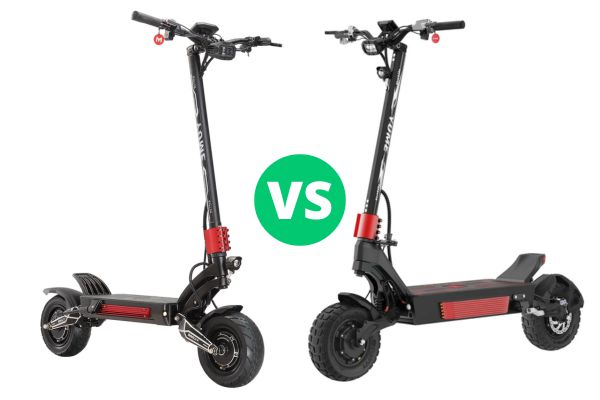Yume is a popular brand in the world of electric scooters. At first, it was known for making affordable scooters. But now, the company has taken a big step forward. It has started building high-performance scooters that compete with the best in the world.
Two models show this change clearly: the Yume Predator and the Yume Raptor. These scooters are not just regular fast rides. They are designed for people who want powerful machines that push the limits of what an electric scooter can do.
The Predator is Yume’s top-tier scooter. It is full of advanced features and technology. It was created to prove that Yume can build scooters as good as, or even better than, big-name brands. It uses features like water-cooled controllers and automotive-grade batteries, which are usually seen in electric cars.
On the other hand, the Raptor is a smart and practical choice. It offers serious performance at a much lower price. It’s not trying to be the most powerful scooter ever made. Instead, it’s built to give you a lot of fun and power without breaking the bank.
In this article, we will explore both scooters in detail. We will look at their power systems, designs, safety features, and more. We’ll help you decide not just which scooter is better on paper, but which one is the right choice for your needs, lifestyle, and budget.
YUME Predator Vs Raptor: A Comprehensive Specification Breakdown
Let’s first look at the basic specs side by side. This helps us understand where each scooter stands in terms of power, speed, and features.
| Feature | Yume Predator | Yume Raptor |
| Top Speed | 63 mph (100 km/h) | 50 mph (80 km/h) |
| Range | 100 miles (160 km) | Up to 60 miles (96 km) |
| Climb Angle | 35-45 degrees | 35-40 degrees |
| Motor Power (Nominal) | Dual 4000W (8000W total) | Dual 3000W (6000W total) |
| Motor Power (Peak) | Over 10,000W | 6000W |
| Battery Voltage | 72V | 60V |
| Battery Capacity | 50Ah | 30Ah or 27Ah |
| Battery Energy | 3600Wh | 1800Wh or 1620Wh |
| Battery Cells | Panasonic EV Cells | Samsung 21700 Cells |
| Battery Life | 2000 cycles | ~500 cycles |
| Controller Type | Custom Sine Wave | Super 6 MOSFET Sine Wave |
| Cooling System | Water-cooled | Air-cooled |
| Frame Material | 6061 Aluminum | 6061 Aluminum |
| Suspension | Triple Hydraulic Shocks | Dual Hydraulic Shocks |
| Tire Size | 13” x 4.73” | 11” x 3.95” |
| Weight | 170 lbs (77 kg) | 92 lbs (42 kg) |
| Rider Load | 330 lbs | 330 lbs |
| Brakes | Quad-Piston Hydraulic | Dual-Piston ZOOM Hydraulic |
| E-Brake | Yes | Yes |
| Display | Large TFT (Color) | Large LCD (Monochrome) |
| Security | NFC Keycard | NFC Keycard |
| Certification | UL2272 Certified | UL2272 Certified |
| Price | ~$3,599 | ~$1,590 – $1,790 |
| Charging Time | 6-7 hrs (dual 5A) | 7-8 hrs (dual 2A) |
| Portability | Not Portable | Foldable & Transportable |
YUME Predator Vs Raptor: The Heart of the Beast
Raw Power: Motor Output and Real-World Acceleration
The Predator has two powerful 4000W motors, giving it a total of over 10,000W peak power. That’s why it can reach very high speeds and handle heavy riders or steep hills easily.
The Raptor has dual 3000W motors, with a peak of 6000W. It’s fast and thrilling, but not as crazy as the Predator. However, for many riders, the Raptor already feels blistering fast and exciting.
The Predator has a small delay in acceleration when starting. This is done on purpose for safety. If it applied full power instantly, it could spin out or be hard to control. This slow start helps make the ride smoother and safer.
The Raptor feels faster off the line. But it may be limited by software to avoid issues like stem wobble or instability. So while both scooters are fast, they are tuned differently for rider safety and control.
The Command Center: Controller Technology and Thermal Management
Controllers are what manage how power flows from the battery to the motor.
The Predator uses custom-tuned sine wave controllers with liquid cooling. This is a rare and premium feature. It prevents overheating, so you can enjoy maximum power for longer rides.
The Raptor uses air-cooled sine wave controllers with metal fins to release heat. This setup is effective and much cheaper. It’s perfect for its 6000W system, even if it can’t match the Predator’s extreme power for long periods.
The Fuel Tank: A Fundamental Divide in Battery Philosophy
The battery is where the biggest difference lies.
The Predator has a 72V 50Ah battery using automotive-grade Panasonic cells. These cells are big, fewer in number, and built for 2000 charge cycles. That means the battery could last up to 10 years or more.
The Raptor uses 60V 30Ah or 27Ah packs made from Samsung 21700 cells, which are high-quality but only last about 500 cycles. This means it may need battery replacement in 2-4 years if used heavily.
If you want a scooter that will last a long time without worrying about the battery dying, the Predator is the better choice. If you’re okay replacing the battery later, the Raptor gives great short-term value.
The Skeleton: Frame Integrity, Weight, and Portability
Both scooters use strong aluminum frames. But they feel very different because of their weight.
The Predator weighs 170 lbs. This makes it hard to lift or move. It’s ideal for someone who can store it in a garage and ride straight from home.
The Raptor weighs 92 lbs. It’s not light, but you can still fold it and lift it into a car with effort. It’s better for someone who lives in an apartment or travels with their scooter.
Taming the Road: A Tale of Two Suspension Systems
The Predator uses three hydraulic shocks, two at the back, one in front. These can be adjusted for softness or stiffness. It makes the ride very stable, especially at high speeds.
The Raptor uses two shocks, one front, one rear. These are longer and work well for off-road or city riding. They aren’t adjustable, but they handle rough roads nicely.
The Point of Contact: The Critical Role of Tire Size
The Predator has huge 13-inch off-road tires. These roll over bumps easily and give a smooth, stable ride. This helps when riding fast or on uneven roads.
The Raptor has 11-inch tires, which are still large but more nimble. They offer good control and make the scooter feel quicker in turns. It’s a good mix of comfort and fun.
Stopping Power: A Comparative Analysis of Braking Systems
The Predator has quad-piston brakes, which are usually found in motorcycles. They offer amazing stopping power, which is necessary for a scooter this fast and heavy.
The Raptor uses dual-piston ZOOM brakes plus an electronic braking system (EBS). EBS adds extra stopping force and helps reduce wear on the brake pads.
The Rider’s Cockpit: Displays, Controls, and Features
- The Predator features a bright, full-color TFT display that shows speed, battery, and ride modes. It’s waterproof and very modern.
- The Raptor uses a simpler LCD screen, which is still large and clear. It shows all the needed info, but doesn’t look as fancy.
- Both scooters have app support and NFC keycard unlocking, which adds security and convenience.
Seeing, Being Seen, and Staying Safe
- Both scooters include strong front headlights, turn signals, rear lights, and horns.
- They also have an IP54 rating, so you can ride in light rain.
- Importantly, both are UL2272 certified, which means they have passed strict safety checks. This makes them safer to store and charge at home.
The Final Verdict
The Predator Profile: The Uncompromising Enthusiast
If you’re someone who wants the best of the best, the Predator is made for you.
- You don’t mind the high price because you’re buying long-term value.
- You likely have a garage or dedicated storage.
- You want super high speeds, long range, and the confidence of top safety features.
- You see this scooter as an adventure machine, not just for quick errands.
The Raptor Profile: The Pragmatic Power Seeker
If you’re looking for thrill and value, the Raptor is the smarter option.
- You want top speed and fun, but also need to stay within a budget.
- You may live in a place where portability matters, like an apartment.
- You want a balanced scooter with enough power for fun, but without the hassle of massive weight.
Conclusion
The YUME Predator and YUME Raptor are two sides of the same coin, both designed to dominate the high-performance electric scooter space with raw power and aggressive design. Yet, while they share many similarities in form factor and intent, their differences reveal distinct identities that cater to different types of riders.
The YUME Predator stands as the more refined, balanced machine. It offers higher peak power (8000W), a higher top speed (60+ mph), and slightly better build materials, positioning it closer to the true “hyper scooter” echelon. Its improved ride feel, superior torque curve, and slightly more polished suspension system make it better suited for seasoned riders who demand more from their machine, whether on urban streets or rugged off-road trails.
The Predator is also better equipped for sustained high-speed rides, thanks to its slightly larger battery and cooling considerations. It’s a logical step up for users who have already experienced budget performance scooters and are ready to enter the premium space, without paying full Dualtron-level prices.
On the other hand, the YUME Raptor is unapologetically raw. It delivers aggressive acceleration, thrilling power delivery, and enough performance to outpace most scooters under $2,500. With its 6000W peak output, the Raptor isn’t far behind the Predator in straight-line power, and it offers a similarly bold, rugged frame built for fun.
However, its cost-saving measures show in the form of slightly reduced suspension performance, build precision, and long-range reliability. It’s ideal for budget-conscious riders who want maximum speed and torque for the price, particularly those who enjoy tinkering or customizing their scooters.
Where the Predator feels more like a serious long-term investment for advanced riders seeking versatility and range, the Raptor is a bang-for-your-buck thrill ride, best suited for shorter urban commutes, casual off-roading, or weekend adrenaline bursts.
Both scooters deliver serious power, large batteries, and hydraulic braking systems, which place them far above entry-level offerings. But choosing between them ultimately depends on your riding style, budget, and expectations. If you want the absolute best performance YUME currently offers, the Predator is your go-to. If you want nearly the same thrill at a lower price, and don’t mind compromising slightly on refinement, the Raptor remains a worthy rival.




